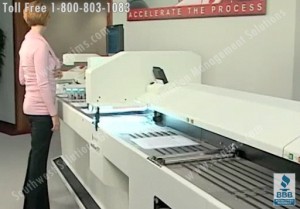Posts Tagged ‘Records management solutions’
Is There a Real ROI for Document Scanning?
In the World of Document Scanning It’s Time to Stop Playing Games
I have conducted hundreds of assessments for companies and government agencies of all sizes over the past 20 years that we interested in document scanning. My consulting style is straightforward and direct, and my recommendations are always based on actual existing conditions as opposed to presumed processes. Although it’s not always easy to hear, most management and executive teams can quickly grasp the big picture of problem identification to resolution. They see it from a three dimensional perspective that includes operations, sales, compliance, and customer service. It is more efficient to gather those who may be vested in the results of a decision at the start of the process rather than trying to repeat and/or “sell” the concept later in the game and expending time and resources on “playing the procurement” game.
Document Scanning ROI is More Complex than Just Line Items and Hard Cost Components
One of the best pieces of advice I received early in my career came from a self-proclaimed dogmatic CFO who had an open disdain for sales; this guy could spin numbers faster than Rain Man. His response to my extensive document scanning ROI analysis was short, but definitely not sweet. He said, “Don’t ever try to sell a ROI to a numbers guy; you will always lose”. There’s no great ending to the story. They didn’t launch the document scanning project, and I didn’t have a slick comeback. His advice, however, made perfect sense. Line item document scanning ROI analyses look great when the hard cost components are equalized, but measuring soft costs associated with the benefits of technology, resource efficiencies (LEAN principles such as wasted human talent), or progress can be tricky.
What’s in the Box?
At the end of the day, some decisions are made because they make sense despite the balance sheet. For example, some organizations dismiss document scanning when compared to storing documents off-site. Why pay $100-$150 to scan a box of documents when it can be stored off-site for $6 a year? It could take 25 years to see a ROI on that expense, assuming the box is even kept that long. And in many cases, this is a solid argument. The problem with this scenario, however, is that the decision is typically made across the board for all documents, each having a unique set of criteria.
Additionally, this scenario is supported by a list of assumptions. For example, this ROI assumes that the documents are never retrieved again (if so, there are costs associated with retrieval, transportation, and re-filing). It also assumes that the contents of each box have been documented and that someone is managing the retention to ensure the box is destroyed at some point. If not, then the yearly cost is infinite. Over time, a combination of loose policy and continued personnel turnover can result in significant off-site storage bills for thousands of boxes. Does anyone really know what’s in most of those boxes? It’s pretty amazing what we find when we do an off-site storage assessment. Un-labeled boxes filled with Christmas decorations, or boxes labeled “John’s right side drawer”. We once located a large volume of boxes that had been labeled “Not sure”. We can laugh about it now, but I can assure you that no one was laughing at the time! Even boxes that have descriptions are destined to live off-site forever because with all the publicity surrounding the destruction of documents; no one wants to pull the trigger to shred.
The Soft Costs Associated with Managing Paper
There is also the litany of soft costs that, although very real, do not have predetermined values. For example, the cost to reproduce documents or information that may already exist is like paying a bill twice; we don’t know what we don’t know. The “simple math” storage cost comparison of document scanning versus off-site storage usually doesn’t include all the costs associated with managing paper: file folders; labels; boxes; storage equipment; labor to create and retrieve files; searching for missing files; interfiling documents; copy documents; or the physical space to store them before they go off-site. Depending on the values each organization might assign to the cost of managing paper, the ROI for document scanning can spin in a million directions. This type of analysis usually focuses on the financial impact of a proposed business decision, but that’s like comparing the cost of typewriters to computers. If we had the same approach back then, we would still be loading carbon paper.
Now don’t go running off to scan everything in off-site storage! The sins of the past may be best handled in a different way. But you can stop the bleeding. At some point, there is a stage in the lifecycle when paper not only starts to lose its value, but also can actually cost more than you bargained for.
Keep Moving Forward with the Digital Data Imaging Migration
Ultimately, there is an element of progress that will be difficult to quantify and yet will likely provide the most sound data towards the digital data imaging migration decision. Remember the typewriter analogy? The cost differential was vast and the benefits were not only uncertain, but also rarely utilized to their full potential. That still holds true today, but organizations nevertheless need to keep moving forward. Hopefully, we will do so having learned something along our technology journey. Forward progress isn’t taken in a single step; it’s a process.
——————————————————————————————————————————————————————————————-
Anna Stratton is Director of Information Management Solutions at Southwest Solutions Group headquartered in Dallas, Texas. Anna specializes in records management and business process protocols, document scanning, policy design, and information retention policies and process. Anna has over 18 years of professional business management experience and provides advice nationwide through the SYSTEC Group’s “Ask the Expert” column. Ms. Stratton is also a dynamic national speaker and conducts private corporate seminars on a variety of topics in addition to providing keynote and educational speeches for organizations such as ARMA and the Lorman Seminar Group. Ms. Stratton has been recognized by Cambridge Who’s Who for demonstrating dedication, leadership and excellence in information and asset management.Document Scanning isn’t an All or Nothing Proposition
Don’t Sell Me!
There is nothing more frustrating than someone trying to sell you something – regardless if you need it or not. Nothing infuriates me more than vendors who walk into a client’s office with a cute little portable scanner, a stack of paper, and a promise of life in digital Shangri-La! Document scanning isn’t about putting paper through a machine. It’s also not an “all or nothing” proposition. I visit with clients who have thousands of files that occupy miles of space and require scores of resources who have been lulled into thinking that the only way to stop the bleeding is to spend millions of dollars on document scanning. The result is that each year the paper grows and their perception of change only get more expensive.
Getting Started with Document Scanning
Migrating to the electronic document world can involve a lot of steps, but as someone once told me, I can guarantee you will never score if you don’t shoot! We don’t need enterprise wide spends to get started and quite frankly, it’s why so many organizations have been burned. The key is identifying a core document type or file set that brings you the best return (we’ll talk about ROI soon) and allows you to ease your way into the change. For example, you can start with scanning documents from your most recent year or perhaps consider core documents within a file that have a high retrieval rate. Maybe you have documents that are mission critical and the only copy you have is in paper format. The key to getting started with document scanning is not feeling the pressure to bang it all out at once but having a conversation about where it makes sense to start. We have clients that send us one box a week or sometimes just one box a month! At the end of the year, they’re 100,000 pages farther along than they were before or at least they haven’t added to the mountain they already have.
Understanding How Document Scanning Will Work for You
With today’s advancements in technology and process efficiencies, there are few organizations that cannot afford to begin outsourcing this task. The options today are almost unlimited and creative approaches – not pre-determined solutions – should be the way we approach our options. Putting paper through a scanner is not rocket science. The key to success is understanding how those documents are being used, why those documents should (or in some cases, shouldn’t be) scanned, and making sure that whatever you do today will work as you progress into new technology applications and platforms. I’ll say it again – there is no one size fits all solution – but there are many document scanning solutions and the right one needs to be the one that works best for you.
——————————————————————————————————————————————————————————————-
Anna Stratton is Director of Information Management Solutions at Southwest Solutions Group headquartered in Dallas, Texas. Anna specializes in records management and business process protocols, document scanning, policy design, and information retention policies and process. Anna has over 18 years of professional business management experience and provides advice nationwide through the SYSTEC Group’s “Ask the Expert” column. Ms. Stratton is also a dynamic national speaker and conducts private corporate seminars on a variety of topics in addition to providing keynote and educational speeches for organizations such as ARMA and the Lorman Seminar Group. Ms. Stratton has been recognized by Cambridge Who’s Who for demonstrating dedication, leadership and excellence in information and asset management.Digital Imaging Systems for Litigation Support
 Digital imaging technology is increasingly important in litigation support. Law Firms that use digital imaging technology realize immediate performance and productivity gains that improve the management of litigation cases, evidentiary documents, discovery files, due diligence records and boilerplate documents. Southwest Solutions Group is a leading provider of secure high resolution scanning, document coding, Bates stamping and full page OCR scans to assist your law firm.
Digital imaging technology is increasingly important in litigation support. Law Firms that use digital imaging technology realize immediate performance and productivity gains that improve the management of litigation cases, evidentiary documents, discovery files, due diligence records and boilerplate documents. Southwest Solutions Group is a leading provider of secure high resolution scanning, document coding, Bates stamping and full page OCR scans to assist your law firm.
Benefits of Converting to Digital Imaging
There are numerous benefits to converting to digital imaging. First and foremost, no more lost or misfiled documents found in paper-based filing systems. Also, many attorneys have heavy travel schedules, yet they still need access to vital documents. Because our digital filing systems provide secure remote access to information, you can quickly retrieve files when and where they are needed on WIFI connected laptops and handheld devices (Blackberry, iPhone, Androids) safely and securely. Some other cost savings and productivity benefits of converting your  documents to digital imaging are:
documents to digital imaging are:
• Cost savings by reducing the paper file storage requirements will enable your organization to grow, reduce costs, and use floor space for profitable purposes • Cost savings of eliminating off-site storage and document retrieval charges • Increase efficiencies in billable hours and administrative overhead cost savings of making copies and faxing documents • Increase productivity through remote file access using a secure web connection and between offices and departments in different locations (256 Bit SSL Encryption) • Protect your documents from catastrophic loss with a secure disaster recovery plan that provides secure off-site backup and access to information in the event of a disaster • Document workflow, inbound fax receiving, document redaction, editing, and Bates stamping, document consolidation • Integration with your existing Practice Management or Document Management systems • Supplement in house litigation support staff for large cases and remote projects • Unlimited users, document types, and files with no upfront fees • Compatible with most browsers and devices, including iPad, Android, Blackberry, and Mac
Test Our Digital Imaging Services for Free
Our free trial offer includes a full featured document imaging configuration for you to use free for 60 days. There are no restrictions on use within your organization. In addition, we will scan a sample set of files and load them into your viewer to demonstrate the imaging quality of scanned files. We guarantee that our scanned files will be compatible with your practice management and litigation support application.
Why Southwest Solutions Group for Your Digital Imaging System
Southwest Solutions Group is more than a digital imaging conversion company. Southwest Solutions Group has been providing filing products and records management consulting to law firms since 1969. Because we have been helping law firms for years with their paper based filing systems, we understand the flow of critical business documents throughout their lifecycle, from point of creation to final disposition, which offers customers reduced risk and improved operational efficiencies with a verifiable return on investment. We have many qualified information specialists to help you understand the process and protect you from common pitfalls when converting from paper based filing to a document imaging system.
Additional Services by Southwest Solutions Group
We offer many information management services including: • Master planning for converting to document imaging • Document Blowbacks (printing), Bates Stamping. Conversion of digital files (images, worksheets, emails) • Output of load files afro Concordance and other Litigation Support Applications • Backfile scanning of inactive and active records • On-site scanning • High quality production scanning • Packing, purging, and shredding services • Document backup services
Contact us today for more information about our digital imaging free trial at (800) 803-1083 or visit http://www.ssgims.com/legal/


